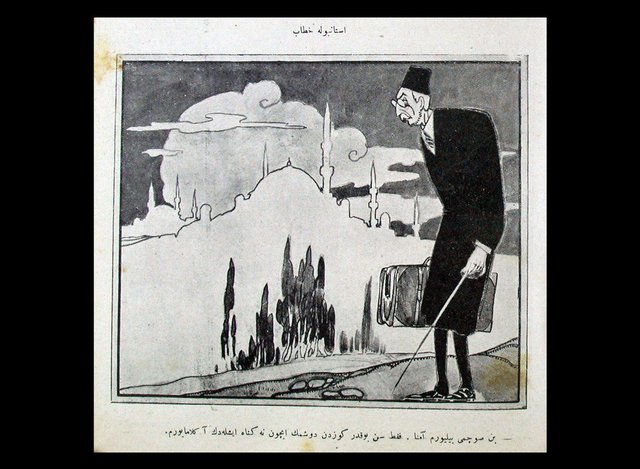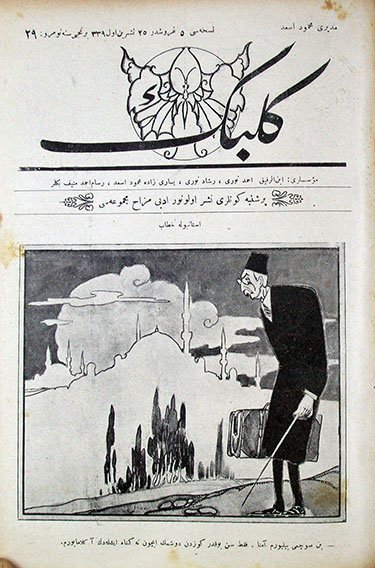120. Today in 1920s Turkey: 25 October 1923 (Innocent Istanbul, You Deserve Better)

(Cartoon by Ahmet Münif, Kelebek or “Butterfly,” 25 October 1923, no. 29, page 1. Atatürk Kitaplığı/Library Collection, Istanbul.)
Türkçe:
(Üstte) İstanbul’a Hitap
(Altta) Ben suçumu biliyorum aminen. Fakat sen bu kadar gözden düşmek için ne günah işledin anlayamıyorum.
English:
(Above) Addressing Istanbul
(Below) Without hesitation I know my crime. But what sin have you committed to fall so sharply from grace, that I do not understand.
Comments
Istanbul, formerly Constantinople, is no average city. By 1923, the year of the present publication, the city had served as the Ottoman capital for 470 years… and the Byzantine capital for over a millennium before that. The city’s architecture, infrastructure, trade ports, history, population, literature, educational opportunities, archives, embassies, commercial industries, and state-of-the-art entertainment facilities were all collectively far more developed than any other city in the country. Above all Istanbul was the print and journalism capital of the country. Most daily as well as weekly publications such as Kelebek were produced in this very city.
In Fall of 1923 the Turkish state was at a crossroads. In the aftermath of WWI Allied forces began partitioning the Ottoman territories when a Nationalist uprising sprung from the central Anatolian town of Ankara. In defiance of the last sultan, Mehmed VI’s orders a resistance war was begun and astonishingly, won. Following this successful War of Independence, the Ankara government abolished the impotent office of the sultanate on 1 November 1922. Roughly a year later, in the weeks and days leading up to the declaration of the government’s form as “Republic” (Cumhuriyet on 29 October 1923) the honor of capital city was assigned to Ankara. This came as an unwelcomed surprise to Istanbul’s press who assumed the title would be restored to their fair city once the war was over and Ankara served its purpose as an alternative seat of government located far away from occupied Istanbul. Of course, the new state with its new form of government wanted to create a new national profile to distinguish itself from its Ottoman predecessor.
Today’s cartoon represents the sentimental discomfort felt by the Istanbul press toward this pivotal change. Conveying a strong sense of nostalgia, the cartoon brings the ghost-like figure of Mehmet VI, the final Ottoman sultan back to city’s familiar outskirts. Although Istanbul had been the home of himself and generations of his forefathers, he stands in her presence wearing a coat and holding a luggage and cane. He is still itinerant, still in exile. He stands hunched and broken, himself sorrowful for the fate of his former capital. And indeed, the city’s picturesque skyline accented with domes, semi-domes, and minarets embellishes the the background while melancholy clouds hang suspended over the imperial monuments. The iconic monuments receding into the background coupled with the reappearance of the sultan from-the-past provide a fictional image that nonetheless appears historical. Here, we witness the past and present coming asymptotically close to one another, or perhaps even overlapping.
This is in fact the second cartoon produced by the cartoonist, Ahmet Münif Bey on the subject of Istanbul’s “demotion.” A week earlier Kelebek featured a front-page cartoon by the artist in which Ankara was rendered as an enthroned old hag being served a crown by personifications of the former Ottoman capital cities of Bursa (1326-1363), Edirne (1363-1453), and Istanbul (1453-1923)—all of which were represented as beautiful, elegant maidens. The cartoon, which was discussed last year in Today in 1920s Turkey post #26, demonstrates how cultured, cosmopolitan Istanbulites viewed Ankara’s qualifications for “capital city” status.
Common undercurrents in Kelebek’s cover cartoons at this moment of rapid, head-spinning change include nostalgia and signs of pain and collective trauma. Another recent cartoon from the cover-page of Kelebek uses the analogy of animal mutilation to depict the territorial changes that occurred between the late Ottoman Empire and the new Turkish state. Read more about it here. Suffice to say, change is never easy.

(Entire page, Kelebek or “Butterfly,” 25 October 1923, no. 29, page 1. Atatürk Library Collection, Istanbul.)